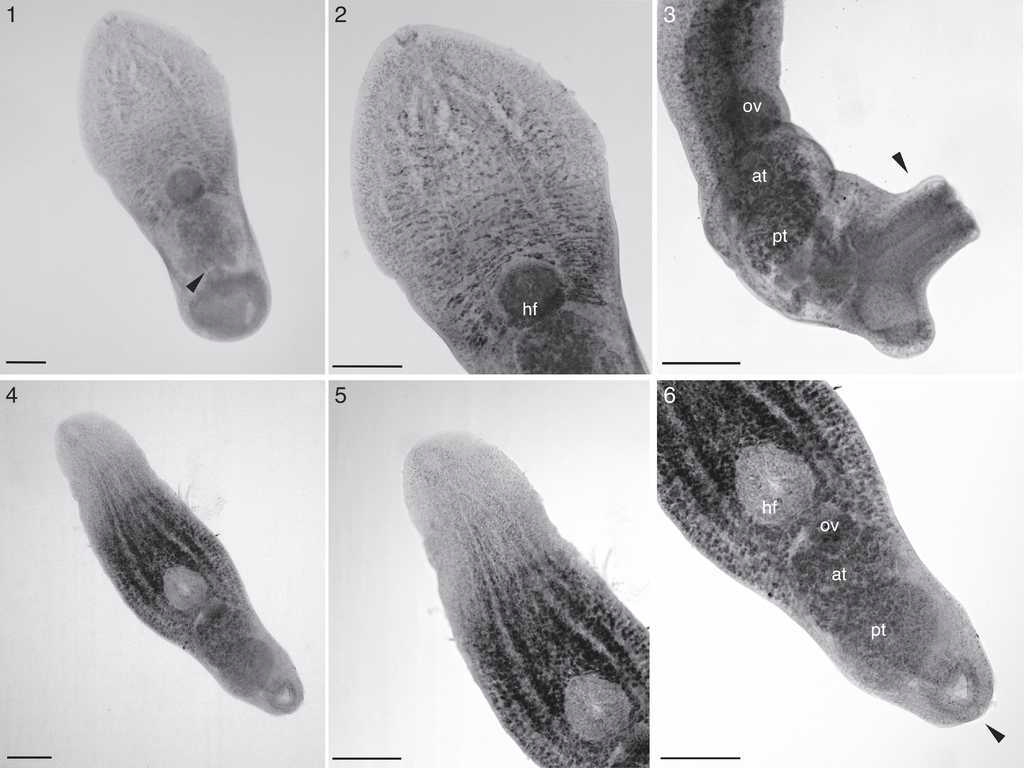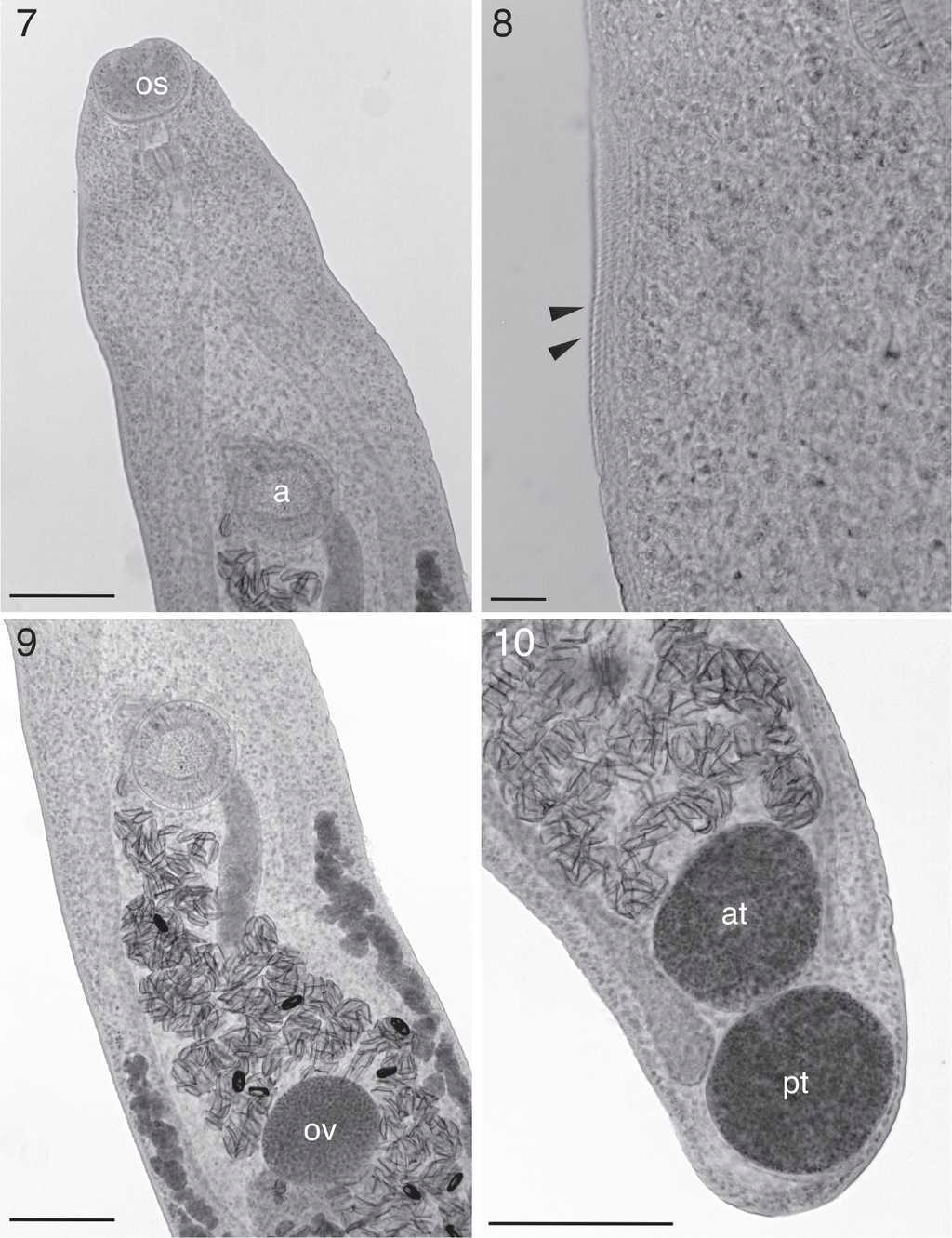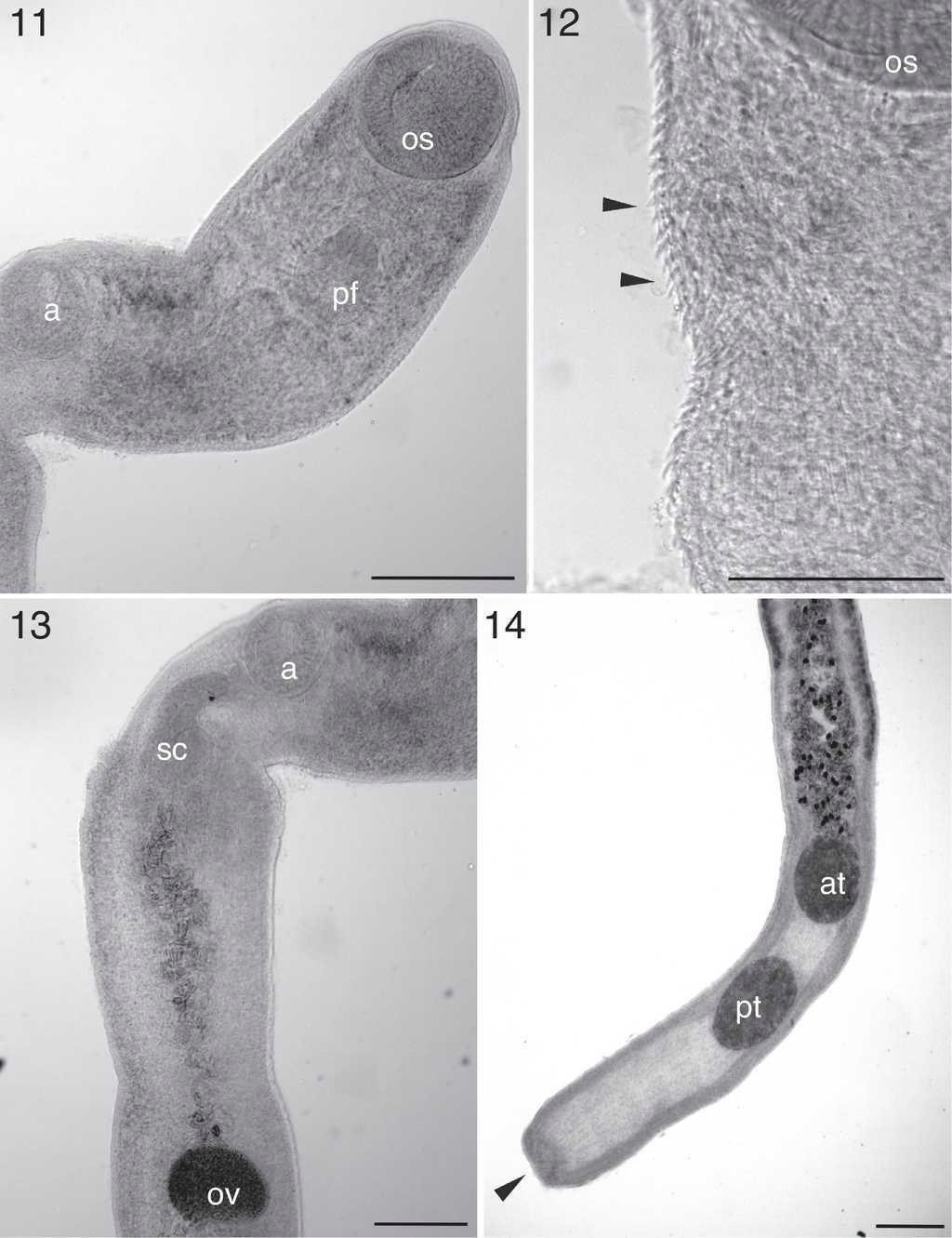Introduction
Knowledge on the helminth diversity in freshwater turtles from South America consists of reports carried out mainly in Uruguay, Argentina, and Brazil (Fernandes & Kohn, 2014). Recently, in southern Brazil, the helminth fauna of these hosts have been investigated resulting in new records of species of Nematoda and Digenea, as well as their infection rates in freshwater turtles of Emydidae and Chelidae (Bernardon, Valente, & Müller, 2014; Mascarenhas & Müller, 2013, 2015a,b; Mascarenhas, Souza, Coimbra, & Müller, 2013).
Phrynops hilarii (Duméril et Bibron, 1835) (Chelidae) known as Saint-Hilaire's side necked turtle occurs in Brazil, Uruguay, Paraguay and Argentina (Djik, Iverson, Rhodin, Shaffer, & Bour, 2014). In Brazil, it occurs in the states of Santa Catarina and Rio Grande do Sul (Djik et al., 2014).
The spiny-necked turtle, Acanthochelys spixii (Duméril et Bibron, 1835) (Chelidae), can be found in Uruguay, Argentina, and Brazil (Djik et al., 2014). In Brazil, it occurs in the states of Bahia, Goiás, Minas Gerais, São Paulo, Paraná, Santa Catarina, Rio Grande do Sul, and in the Federal District (Brasil, Horta, Fraxe-Neto, Barros, & Colli, 2011; Djik et al., 2014). In the state of Rio Grande do Sul, this species is associated with sandy lagoon environments, wetlands and seasonal or semi-permanent ponds (Bujes & Verrastro, 2008).
Regarding the knowledge of helminths of the 2 species there are some studies conducted in Uruguay, Argentina and Brazil (Table 1). The current study has the objective of reporting the presence of Digenea in the freshwater turtles, P. hilarii and A. spixii, and contributing to the knowledge of helminth parasite biodiversity in these hosts.
Table 1 Helminths of Phrynops hilarii (Duméril et Bibron, 1835) and Acanthochelys spixii (Duméril et Bibron, 1835) (Testudines: Chelidae) from South America.
| Hosts | Helminths | Geographic distribution | References |
|---|---|---|---|
| Phrynops hilarii | Digenea | ||
| Cryptogonomidae | |||
| Caimanicola brauni (Mañé-Garzón et Gil, 1961) | Uruguay; Argentina | Mañé-Garzón & Gil (1961c); | |
| Timoniella ostrowskiae Brooks, 1980 | Uruguay | Fernandes & Kohn (2014) | |
| Cladorchiidae | Fernandes & Kohn (2014) | ||
| Nematophila grandis (Diesing, 1839) | Argentina | Lombardero & Moriena (1977) | |
| Echinostomatidae | |||
| Prionosoma phrynopsis Mañé-Garzón et Gil, 1961 | Uruguay | Mañé-Garzón & Gil (1961c) | |
| Prionosomoides scalaris Freitas et Dobbin Jr., 1967 | Argentina | Lombardero & Moriena (1977) | |
| Telorchiidae | |||
| Telorchis birabeni Mañé-Garzón et Gil, 1961 | Uruguay; Argentina | Mañé-Garzón & Gil (1961a) ; Lombardero & Moriena (1977) | |
| Telorchis productus Mañé-Garzón et Gil, 1961 | Uruguay | Mañé-Garzón & Gil (1961b) | |
| Proterodiplostomidae | |||
| Cheloniodiplostomum testudinis (Dubois, 1936) | Argentina | Lombardero & Moriena (1977) | |
| Cheloniodiplostomum sp. | Brazil | Bernardon et al. (2013) | |
| Monogenoidea | |||
| Polystomatidae | |||
| Polystomoides uruguayensis Mañé-Garzón et Gil, 1961 | Uruguay | Mañé-Garzón & Gil (1961d) | |
| Polystomoides fuquesi Mañé-Garzón et Gil, 1962 | Uruguay | Mañé-Garzón & Gil (1962) | |
| Nematoda | |||
| Gnathostomatidae | |||
| Spiroxys sp. | Brazil | Bernardon et al. (2013) | |
| Camallanidae | |||
| Camallanus sp. | Brazil | Bernardon et al. (2013) | |
| Acanthochelys spixii | Gnathostomatidae | ||
| Spiroxys contortus (Rudolphi, 1819) | Brazil | Mascarenhas et al. (2013) | |
| Camallanidae | |||
| Camallanus sp. | Brazil | Mascarenhas et al. (2013) |
Materials and methods
The turtle specimens examined were collected between October 2011 and November 2014; dead roadkill victims on highways in the southern region of the State of Rio Grande do Sul (Brazil), in the municipalities of Pelotas; (31°45′02.8″ S-52°20′38.7″ W; 31°43′49.1″ S-52°22′43.3″ W; 31°44′45.6″ S-52°21′43.3″ W; 31°44′47.9″ S-52°24′28.7″ W; 31°45′34.6″ S-52°24′09.4″ W; 31°45′54.2″ S-52°23′03.3″ W; 31°46′11.6″ S-52°21′57.9″ W), Capão do Leão (31°47′36.7″ S-52°24′28.8″ W; 31°47′40.3″ S-52°24′27.7″ W); Rio Grande (32°20′58.5″ S-52°32′43.77″ W); and Santa Vitória do Palmar (33°15′16.22″ S-53°05′00.1″ W). A total of 14 specimens of A. spixii (5 males and 9 females), and 5 P. hilarii (1 male and 4 females) were necropsied. Nine hosts were frozen (7 A. spixii and 2 P. hilarii), and 10 were processed immediately after death (7 A. spixii and 3 P. hilarii). The stomach, as well as the small and large intestines were opened and washed under running water in a 150 μm sieve to separate the helminths. The material retained on the sieve and the mucous membranes were inspected under a stereomicroscope. The cavity was also washed and its content examined. The Digenea were fixed in AFA (ethanol 70°, formalin 37%, and glacial acetic acid), and then preserved in ethanol 70°. Some specimens were stained in Delafield's hematoxylin or Carmine's Langeron, and mounted as permanent slides in Canada balsam, and identified according to Lombardero and Moriena (1977), Dubois (1979), Mañé-Garzón and Gil (1961a,b), Travassos, Freitas, and Kohn (1969). Vouchers were deposited in the Coleção de Helmintos do Laboratório de Parasitologia de Animais Silvestres (CHLAPASIL/UFPel), Rio Grande do Sul State, Brazil; Coleção Helmintológica do Instituto Oswaldo Cruz (CHIOC), Rio de Janeiro State, Brazil, and Coleção de Invertebrados, Museo de La Plata (MLP-He), La Plata, Argentina. Measurements are expressed in millimeters (mm), and averages appear in parentheses. The parasitological indices: prevalence, mean intensity, and mean abundance of infection, were estimated according to Bush, Lafferty, Lotz, and Shostak (1997). The parasitic range of variation was presented according to Bush, Fernandez, Esch, and Seed (2001). The photomicrographs were taken using an Olympus® BX 41 Microscope, with a camera adapter system. The photomicrograph plates were prepared using Adobe Photoshop® CS5.
Descriptions
Family Proterodiplostomidae
Cheloniodiplostomum sp. (Figs. 1-3)
Based on 18 adult specimens (8 were measured). Body divided into 2 parts by constriction at level of the posterior edge of the anterior testis. Body length 1.2-1.45 (1.32), forebody length 0.77-0.98 (0.85), forebody width (at the level of the acetabulum) 0.40-0.55 (0.49), hindbody length 0.38-0.56 (0.47), hindbody width (at the level of anterior testis) 0.26-0.35 (0.33), oral sucker length 0.03-0.05 (0.05), oral sucker width 0.03-0.07 (0.05), pharynx length 0.04-0.05 (0.04), pharynx width 0.02-0.05 (0.04), esophagus length 0.02-0.07 (0.05), acetabulum length 0.05-0.06 (0.05), acetabulum width 0.06-0.07 (0.07), holdfast length 0.07-0.12 (0.10), holdfast width 0.08-0.15 (0.11), ovary length 0.04-0.08 (0.06), ovary width 0.06-0.14 (0.10), anterior testis length 0.07-0.12 (0.20), anterior testis width 0.14-0.20 (0.17), posterior testis length 0.08-0.12 (0.10), posterior testis width 0.17-0.23 (0.20), eggs length 0.09-0.11 (0.10), eggs width 0.05-0.07 (0.06), (11 eggs measured). Presence of 1 to 2 eggs by helminth.

Figures 1-6. 1-3, Cheloniodiplostomum sp. (Digenea: Proterodiplostomidae) parasite of Acanthochelys spixii (Testudines: Chelidae) from Southern Brazil. 1, ventral view, egg (arrow) (bar=150μm); 2, ventral view of forebody, hf-holdfast (bar=150μm); 3, lateral view of hindbody, well-developed genital cone (arrow), ov-ovary, at-anterior testis, pt-posterior testis (bar=180μm). 4–6. Cheloniodiplostomum testudinis (Digenea: Proterodiplostomidae) parasite of Phrynops hilarii (Testudines: Chelidae) from Southern Brazil. 4, ventral view (bar=160μm); 5, ventral view of forebody (bar=160μm); 6, ventral view of hindbody, genital cone (arrow), hf-holdfast, ov-ovary, at-anterior testis, pt-posterior testis (bar=160μm).
Taxonomic summary
Host: Acanthochelys spixii (Duméril et Bibron, 1835).
Infection site: small intestine and large intestine.
Sampling site: Capão do Leão, Rio Grande do Sul, Brazil (31°47′36.7″ S-52°24′28.8″ W).
Prevalence: 7.1% (1/14).
Mean intensity: 128.
Mean abundance: 9.1.
Range of variation: 128.
Specimens deposited: 587-594 (CHLAPASIL-UFPel); 36733, 38044a-38044c (CHIOC); 6839-6841 (MLP-He).
Cheloniodiplostomum testudinis (Dubois, 1936) (Figs. 4-6)
Based on 35 specimens (5 adult and 5 immature were measured). Adults: Body divided into 2 parts by a constriction located at the level of the ovary and anterior testis. Body length 1.47-1.80 (1.71), forebody length 1.02-1.32 (1.25), forebody width (at the level of the acetabulum) 0.28-0.37 (0.33), hindbody length 0.41-0.52 (0.45), hindbody width (at the level of anterior testis) 0.25-0.3 (0.27), oral sucker length 0.04-0.06 (0.05), oral sucker width 0.03-0.07 (0.05), pharynx length 0.05-0.06 (0.16), pharynx width 0.03-0.05 (0.04), esophagus length 0.06-0.13 (0.08), acetabulum length 0.03-0.06 (0.05), acetabulum width 0.04-0.05 (0.05), holdfast length 0.15-0.19 (0.17), holdfast width 0.11-0.15 (0.13), ovary length 0.07-0.10 (0.08), ovary width 0.07-0.09 (0.08), anterior testis length 0.16-0.21 (0.18), anterior testis width 0.20-0.23 (0.22), posterior testis length 0.11-0.17 (0.14), posterior testis width 0.23-0.24 (0.23), eggs length 0.08-0.10 (0.09), eggs width 0.04-0.06 (0.05), 18 eggs measured. Presence of 1 to 10 eggs by helminth.
Immatures: Body divided into 2 parts by a mild constriction at the level of the anterior edge of the anterior testis. Body length 0.85-1.17 (0.99), forebody length 0.67-0.91 (0.79), forebody width (at the level of the acetabulum) 0.22-0.32 (0.28), hindbody length 0.18-0.22 (0.20), hindbody width (at the level of anterior testis) 0.17-0.22 (0.19), oral sucker length 0.04-0.05 (0.04), oral sucker width 0.04-0.05 (0.04), pharynx length 0.04-0.05 (0.04), pharynx width 0.02-0.04 (0.03), esophagus length 0.08-0.12 (0.09), acetabulum length 0.04-0.05 (0.05), acetabulum width 0.05-0.06 (0.05), holdfast length 0.09-0.15 (0.12), holdfast width 0.10-0.14 (0.11), ovary length 0.02-0.07 (0.03), ovary width 0.08-0.10 (0.09), anterior testis length 0.02-0.05 (0.03), anterior testis width 0.06-0.11 (0.09), posterior testis length 0.02-0.07 (0.04), posterior testis width 0.07-0.16 (0.10).
Taxonomic summary
Host: Phrynops hilarii (Duméril et Bibron, 1835).
Infection site: small intestine.
Sampling site: Pelotas, Rio Grande do Sul, Brazil (31°45′02.8″ S-52°20′38.7″ W).
Prevalence: 60% (3/5).
Mean intensity: 57.7.
Mean abundance: 28.8.
Range of variation: 53-62.
Specimens deposited: 595-604 (CHLAPASIL-UFPel); 35999, 36734, 38045a-38045e (CHIOC); 6836-6838 (MLP-He).
Remarks
According to the key proposed by Dubois (1979), the genus Cheloniodiplostomum Sudaricov, 1960 includes 2 species, C. testudinis (Dubois, 1936), C. brevis (MacCallum, 1921) [= C. cinosterni (MacCallum, 1921)], and C. delillei (Zerecero, 1947).
Cheloniodiplostomum brevis was described in Kinosternon scorpioides (Linnaeus, 1766) in Trinidad (MacCallum, 1921), and C. delillei in Chelydra serpentine (Linnaeus, 1758) in Mexico (Zerecero, 1947). In South America, C. testudinis was reported in Testudo sp. and Phrynops geoffroanus (Schweigger, 1812) in Brazil (Fernandes & Kohn, 2014; Silva, 2014), and in P. hilarii in Argentina (Lombardero & Moriena, 1977).
The descriptions and reports for the species Cheloniodiplostomum are brief, except for that of Zerecero (1947) who described C. dellilei in detail. Considering the lack of morphological information, changes in the group taxonomy, and in order to generate richer data for a more detailed morphological identification, a complete revision is suggested for the species within the genus.
Cheloniodiplostomum sp. in the present study is very similar to C. dellilei; however, the position of vitellaria in Cheloniodiplostomum sp. is near the caecal bifurcation (Fig. 2) different than C. dellilei that extend from the acetabulum.
The differences observed between C. testudinis and Cheloniodiplostomum sp. in the present study were: length, width, and shape of the body; location of the constriction dividing the body into 2 parts, a well-developed genital cone in Cheloniodiplostomum sp., being a little bulky in C. testudinis (Fig. 6). The number of eggs differs, in Cheloniodiplostomum sp. between 1 to 2 eggs (128 specimens examined) occurred, in C. testudinis, 1 to 10 eggs (115 specimens examined).
The morphometry of C. testudinis described by Travassos et al. (1969), and Lombardero and Moriena (1997) is similar to that found in present study; however, we noticed a smaller body size (1.71 × 0.9 mm), ovary (0.08 × 0.22 mm), and eggs (0.09 × 0.05 mm); though the esophagus was larger (0.08 × 0.09 mm). Adults and immature specimens of C. testudinis in P. hilarii showed small morphometric differences.
Specimens of Cheloniodiplostomum sp. reported for P. hilarii (Bernardon et al., 2013) were examined and it is believed that are C. testudinis, however, the preparation of the specimens of Cheloniodiplostomum sp. did not allowed the specific identification.
Family Telorchiidae
Telorchis platensis Mañé-Garzón et Gil, 1961 (Figs. 7-10)
Based on 6 specimens (4 were measured). Body elongate 3.6-4.2 (3.9) length, 0.425-0.725 (0.56) width (the level of the ovary). Spines in tegument present. Oral sucker 0.14-0.15 (0.14) long, 0.14-0.16 (0.15) wide, pre-pharynx present. Pharynx 0.06-0.07 (0.06) long, 0.05-0.07 (0.06) wide. Esophagus 0.09-0.19 (0.15) long. Acetabulum intercaecal, 0.17-0.2 (0.19) long, 0.16-0.19 (0.18) wide. Anterior testis 0.18-0.23 (0.21) long, 0.22-0.25 (0.24) wide, and posterior testis 0.21-0.25 (0.23) long, 0.22-0.32 (0.25) wide. Ovary 0.15-0.19 (0.18) long, 0.15-0.21 (0.19) wide. Eggs 0.037-0.042 (0.04) long, 0.017-0.022 (0.021) wide.

Figures 7–10 Telorchis platensis (Digenea: Telorchiidae) parasite of Acanthochelys spixii (Testudines: Chelidae) from Southern Brazil. 7, anterior region, os-oral sucker, a-acetabulum (bar=190μm); 8, integument of the anterior region with presence of spines (arrows) (bar=50μm); 9, mid region, ov-ovary (bar=190μm); 10, posterior region, at-anterior testis, pt-posterior testis (bar=250μm).
Taxonomic summary
Host: Acanthochelys spixii (Duméril et Bibron, 1835).
Infection site: large intestine.
Sampling site: Pelotas, Rio Grande do Sul, Brazil (31°43′49.1″ S-52°22′43.3″ W).
Prevalence: 7.1% (1/14).
Mean intensity: 6.
Mean abundance: 0.4.
Range of variation: 6.
Specimens deposited: 569-574 (CHLAPASIL -UFPel).
Telorchis birabeni Mañé-Garzón et Gil, 1961 (Figs. 11-14)
Based on 4 specimens (2 were measured). Body elongate 6.93-7.13 (7.02) long, 0.32-0.37 (0.35) wide (the level of the ovary). Spines in tegument present. Oral sucker 0.23-0.28 (0.25) length by 0.22-0.28 (0.25) width, pre-pharynx present. Pharynx 0.18-0.25 (0.21) length by 0.13-0.16 (0.14) width. Esophagus absent. Acetabulum length 0.14-0.19 (0.16), 0.15-0.19 (0.17) width. Anterior testis 0.23-0.30 (0.26) long, 0.24 wide, and posterior testis 0.28-0.35 (0.31) length by 0.21-0.22 (0.21) width. Ovary 0.14-0.21 (0.17) length by 0.17-0.19 (0.18) width. Eggs 0.022-0.025 (0.023) length by 0.012 width.

Figures 11–14 Telorchis birabeni (Digenea: Telorchiidae) parasite of Phrynops hilarii (Testudines: Chelidae) from Southern Brazil. 11, anterior region, os-oral sucker, ph- pharynx, a-acetabulum (bar=220μm); 12, integument of the anterior region with presence of spines (arrows) (bar=53μm); 13, anterior region, a-acetabulum, cs-cirrus sac, ov-ovary (bar=170μm); 14, posterior region, cupuliform formation characteristic of the species (arrow), at-anterior testis, pt-posterior testis (bar=240μm).
Taxonomic summary
Host: Phrynops hilarii (Duméril et Bibron, 1835).
Infection site: small intestine.
Sampling site: Pelotas, Rio Grande do Sul, Brazil (31°45′02.8″S - 52°20′38.7″W).
Prevalence: 40% (2/5).
Mean intensity: 5.
Mean abundance: 2.
Range of variation: 3-7.
Specimens deposited: 575-578 (CHLAPASIL -UFPel).
Remarks
The species of Telorchis Lühe, 1899 occur in amphibians, reptiles, and especially in freshwater turtles in North America, South America, Europe, and Asia (Font & Lotz, 2008). In America, Telorchis corti Stunkard, 1915 is the most widely distributed species recorded from Canada to southern Brazil (MacDonald & Brooks, 1989; Mascarenhas & Müller, 2013).
Telorchis birabeni and T. platensis were described in Uruguay in P. hilarii, and Hydromedusa tectifera Cope, 1870 (Chelidae), respectively (Mañé-Garzón & Gil, 1961a, b). Telorchis birabeni was reported in P. hilarii in Argentina (Lombardero & Moriena, 1977), and P. geoffroanus in Brazil (Silva, 2014).
Concerning T. platensis in the present study, in the 6 specimens examined it was observed that intestinal caeca ended between the anterior and posterior testis (Fig. 10), never exceeding the testicular zone. This characteristic was not mentioned in the description T. platensis by Mañé-Garzón and Gil (1961b). The specimens collected in A. spixii, in the present study, harbored testis and ovaries approximately 2 times larger than the Uruguayan specimens.
Telorchis birabeni has a characteristic posterior part of body that constitutes a cupuliform formation (Fig. 14), which opens to the excretory pore. According to Mañé-Garzón and Gil (1961a), this characteristic, unique among Telorchis species, justifies the description of a new genus for this species. A review of the species of Telorchiidae of South America could contribute to the description of a new genus.
In both species (T. platensis and T. birabeni) we observed the presence of tegumental spines in higher numbers in the anterior region, and decreasing from the acetabulum. The presence of spines in the tegument is characteristic of the Telorchis species; however, such spines may be lost if the host was frozen before being examined as suggested by Mascarenhas and Müller (2013). The hosts from which T. platensis and T. birabeni were collected were not frozen; therefore, helminths were fixed immediately after collection, allowing the preservation of the spines of the integument.
Telorchis is known to have a considerable degree of intraspecific morphological variation, which has led to discuss the number of species within the genus. Telorchis corti is considered the most problematic of the species, since 13 synonyms have been recorded in North America (MacDonald & Brooks, 1989).
Mañé-Garzón and Gil (1961a) recognized the need for a thorough revision of the genus, which was conducted later by MacDonald and Brooks (1989) with the North American species, and only 11 out of the 31 species described were considered valid. In South America, 14 species of Telorchis were named, being reported in freshwater turtles and snakes (Fernandes & Kohn, 2014; Lenis & Vélez, 2011; Mascarenhas & Müller, 2013). In general, the features used by the authors to differentiate between species were: size of the egg, size of the suckers; vitellaria extension, and the length of the esophagus (Mañé-Garzón & Gil, 1961a,b,c; Mañé-Garzón & Holcmann-Spector, 1968, 1973). These characteristics were considered highly variable in the analysis of Telorchiidae in North America (MacDonald & Brooks, 1989). It would be interesting to carry out a revision of Telorchis species occurring in South America, in the same manner as MacDonald and Brooks (1989), seeking to establish more judicious taxonomic characters for species differentiation within the group, and then comparing the results with the species from North America.
Discussion
Study of the parasitic helminth fauna associated with freshwater turtles in Southern Brazil contributes to knowledge of parasite biodiversity in wild animals. The first report of helminth parasites in A. spixii was made by Mascarenhas et al. (2013), which reported the occurrence of nematodes in this host. Some species of Digenea were described in P. hilarii in the 60's in Uruguay; however, Bernardon et al. (2013) reported for the first time Nematoda in this host.
The Digenea Cheloniodiplostomum sp. and Telorchis platensis are first mentioned in Acanthochelys spixii. The helminths Cheloniodiplostomum testudinis and Telorchis birabeni are cited for the first time parasitizing Phrynops hilarii in Brazil.
Road-killed animals can offer interesting results for helminthological research as observed for freshwater turtles, providing important information about the diversity of their parasites, and on the biology of the hosts, that may contribute to the conservation of the involved species and their habitats.











 nueva página del texto (beta)
nueva página del texto (beta)


